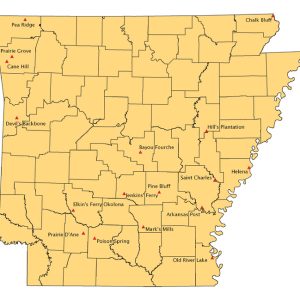calsfoundation@cals.org
Pine Bluff Expedition (January 15–18, 1865)
| Location: | Jefferson County |
| Campaign: | Pine Bluff Expedition |
| Dates: | January 15–18, 1865 |
| Principal Commanders: | Second Lieutenant Charles H. Temple (US); None (CS) |
| Forces Engaged: | M Company, Thirteenth Illinois Cavalry (US); None (CS) |
| Estimated Casualties: | None (US); None (CS) |
| Result: | Union objective complete |
Ordered to lead an expedition to repair downed telegraph lines from the Union-held city of Pine Bluff (Jefferson County), Lieutenant Charles Temple of Company M, Thirteenth Illinois Cavalry, moved his Union forces along the roads and farms around Pine Bluff from January 15 to January 18, 1865, returning to the Thirteenth Illinois Headquarters in Pine Bluff. During the expedition, there was no hostile contact with Confederate forces.
On Sunday, January 15, 1865, Lt. Temple, along with an escort of thirty soldiers from the Thirteenth Illinois Cavalry and a telegraph repair crew, began a movement along the Little Rock Road to repair telegraph lines that had been cut. The party advanced some twelve miles, at which point it discovered a break in the lines and attempted to repair it. The telegraph lines could not be mended, however, due to broken equipment. Temple then began the search for the perpetrators.
Moving five miles south, Temple reached the home of a Mr. Rogers who was in the company of a Dr. Norris, a former surgeon in the Confederate army. Temple searched the property, discovering a length of telegraph wire similar to the length of wire cut from the Little Rock Road, along with a small cache of weapons. Following the discovery, Rogers and Norris were placed in custody and returned to Pine Bluff to the Union headquarters. The identity of the perpetrators was later noted as Benjamin Riggs and John Jones.
At 8:15 a.m. on Monday, January 16, 1865, Temple once again moved his thirty-man party from Pine Bluff to repair the telegraph lines. The lines were successfully repaired, and the party moved south to the home of a Mr. Woods, who was taken prisoner. The next day, the march continued westward to the Hot Springs Road and the home of a Dr. Ursury. Upon arrival at the home, it was found that the doctor was away and the house empty. As the expedition moved farther west along the road, a force numbering about twenty-five was discovered moving into a line formation. Temple deployed his men forward, and the group quickly dispersed without incident.
On January 17, Temple’s party continued the expedition, moving south approximately thirty miles to near White Oak Bluff on the Saline River, where it camped for the night. The following day, Wednesday, January 18, the party moved north to the Camden Road and then followed the road east seven miles to the home of a family by the name of the Hudson. A small cache of weapons consisting of five guns was found, along with several bales of cotton and a cotton gin. A Mr. Alexander was apprehended by Temple at the Hudson home and returned to Pine Bluff.
The expedition returned to its headquarters in Pine Bluff on the afternoon of January 18, with no incident to report. Expeditions of this type were common during this part of the war, as major troop movements declined, to be replaced by small unit operations against guerrilla units.
For additional information:
The War of the Rebellion: A Compilation of the Official Records of the Union and Confederate Armies. Series I, Vol. 48, Part I, pp. 46–47 Washington DC: Government Printing Office, 1891.
Jacob Worthan
Hot Springs, Arkansas
 Civil War Timeline
Civil War Timeline Military
Military ACWSC Logo
ACWSC Logo  Civil War Events Map
Civil War Events Map 




Comments
No comments on this entry yet.